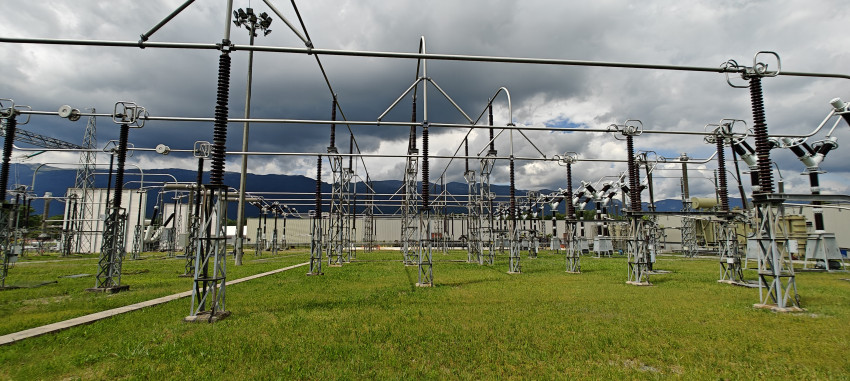
E-lunch webinar: CERN-HV/MV grid network based project in the Large Hadron Collider

Presentation and Recording
Presentation of: Project RF 2.0 Leveraging PMU technology to monitor CERN grid infrastructure, KIVI Webinar, 16-04-2025
Rewatch recording: E Lunch webinar CERN - Zaphiro – ELEQ: presentation of a recent PMU based project in the Large Hadron Collider (CERN) High voltage grid network
EU project targets better energy efficiency at CERN with improved grid monitoring tools
Particle accelerators are energy-intensive, consuming up to hundreds of gigawatt hours annually, comparable to small- or medium-sized European cities. This, combined with their reliance on non-renewable energy sources and significant raw material requirements, pose environmental challenges.
That is why the Research Facility 2.0 (RF2.0) project, funded by the European Union’s Horizon Europe programme and the Swiss State Secretariat for Education, Research and Innovation, is exploring innovative solutions to make accelerators more sustainable.
The project focuses on four points:
Developing new highly efficient components (permanent magnets and solid-state amplifiers)
- Integrating AI-assisted energy management systems
- Adopting low-carbon technologies (energy storage systems, renewable power-driven computing centers)
- Enhancing power consumption flexibility and network services (power electronics, direct current networks, fast measurement systems)
There are 10 partners, including five of the largest particle accelerator facilities in Europe – ALBA Synchrotron (Spain), CERN, Deutsches Elektronen-Synchrotron DESY in Hamburg, Helmholtz-Zentrum Berlin, and MAX IV Laboratory (Sweden) – supported by four specialised technology companies and with Karlsruhe Institute of Technology (KIT) coordinating the consortium.
It is running for three years between 2024 and the end of 2026 and is backed with a total of €5.6 million.
Improving power quality in accelerator electrical power distribution grids
It is still early in the project but there has already been marked progress towards achieving the goal of improving power consumption flexibility and network services at accelerator facilities.
As part of the fast measurement systems developments CERN, together with Swiss smart grid solutions company Zaphiro Technologies, are deploying 24 phasor measurement units (PMUs) in selected locations across CERN’s electrical power grid, as shown in figure 1, significantly enhancing its monitoring capabilities.
By validating these solutions through demonstrator projects, one of which will take place at CERN, RF2.0 seeks to reduce accelerators' environmental impact and benefit other energy-intensive facilities, for example medical centers, data centers and other industrial plants, with innovative, flexible energy management strategies.
CERN - Zaphiro – ELEQ: presentation of a recent PMU based project in the Large Hadron Collider (CERN) High voltage grid network
Particle accelerators are energy-intensive, consuming up to hundreds of gigawatt hours annually, comparable to small- or medium-sized European cities.
Hence, CERN is actively improving its grid monitoring tools and has recently launched Research Facility 2.0 project - deploying 24 phasor measurement units on CERN’s electrical power distribution grid to analyze grid perturbations, improve power quality and develop a digital twin for greater efficiency.
As part of the fast measurement systems developments in this project, CERN, together with Zaphiro Technologies, are deploying 24 phasor measurement units (PMUs) in selected locations across CERN’s electrical power grid - significantly enhancing its monitoring capabilities.
A practical challenge implementing this solution was to make sure the current and voltage measurement will be very accurate – while there was an important constraint that this project should be done only by utilizing the existing primary current transformers at 400kV, 66kV, or 18kV networks.
This challenged was solved together with ELEQ and Zaphiro by using an innovative compact Low Power CT (LPCT) to measure current flow on the secondary side of the existing primary high voltage CT’s and help as a “repeater” to create a mirror of the actual current flow so that the PMU’s do not tolerate data accuracy and data quality.
LPCT, in accordance with the IEC61869-10, offers various possibilities and innovative opportunities to in the past difficult to tackle problems. It can be used in the secondary circuit of an existing protection or measurement transformer, or provide a low power option for direct use around the primary circuit.
In this presentation, CERN, Zaphiro, and ELEQ will jointly present this nice project, its achievement, and the challenges faced through the project design and implementation phases.

Program
11:45 u. - 12:00 u. Call in MS Teams
12:00 u. - 12:05 u. Welcome to KIVI Electrical Engineering
12:05 u. - 12:40 u. Speakers with presentations:
Alice Maffezzoli (Zaphiro) & Jeroen Boekhout (Eleq) & Isabel Amundarain Argüello (CERN)
12:40 u. - 13:00 u. Q&A with questions from the chat
13:00 u. - 13:00 u. Close & End
Bio: Isabel Amundarain Argüello
I am an Electrical Engineer at CERN, working on the RF 2.0 European Project in collaboration with KIT, and other partners to develop guidelines for sustainable particle accelerators, with a focus on electrical network infrastructure.
Previously, I worked at ComEd (Exelon), the DSO for Chicago and Northern Illinois, where I was responsible for distribution planning in two areas of Chicago, including O’Hare Airport. I led projects in grid reliability, voltage optimization, DER integration, and new business initiatives, focusing on critical infrastructure and network resilience.
With a background in power systems, energy transition, and smart grids, I hold a Master’s in Energy Systems and a Master’s in Industrial Engineering. In this webinar, I’ll share insights on the installation of Zaphiro and Eleq technologies in the CERN power distribution grid, exploring how real-time grid monitoring and automation can enhance future research facilities.
Particle accelerators are energy-intensive, consuming up to hundreds of gigawatt hours annually, comparable to small- or medium-sized European cities. This, combined with their reliance on non-renewable energy sources and significant raw material requirements, pose environmental challenges.
The RF 2.0 (Research Facility 2.0) Project, funded by the UE’s Horizon Europe program and the Swiss State Secretariat for Education, Research and Innovation, is a collaborative initiative aimed at defining guidelines for the next generation of sustainable particle accelerators. The project brings together CERN, KIT (Karlsruhe Institute of Technology), and eight other partners, including some of the largest particle accelerator facilities in Europe, to develop energy-efficient and environmentally sustainable solutions for future research facilities.
The project focuses on developing highly efficient components (e.g., permanent magnets, solid-state amplifiers), integrating AI-assisted energy management systems, adopting low-carbon technologies like energy storage systems and renewable-powered computing centers, and improving power consumption flexibility and network services through innovations in power electronics, direct current networks, and fast measurement systems.
A major aspect of the project is the optimization of the electrical infrastructure to ensure grid stability, reliability, and integration of renewable energy sources. This aligns with global efforts to make large-scale scientific research more energy-efficient and environmentally sustainable.

Bio: Alice Maffezzoli (Zaphiro)
Alice Maffezzoli, engineer specializing in the energy sector, holds a Master’s in Electrical Engineering from the University of Pavia, and an additional BSc in Mechanical Engineering in Denmark, and an International MBA from MIP Politecnico di Milano.
She previously worked at ABB, focusing on system integration and optimization in the oil and gas industry, as well as hydrogen and fuel cell technologies. Currently, as Sales and Business Development Manager at Zaphiro Technologies, she promotes advanced solutions for grid reliability and efficiency.
With a strong technical background and a focus on clean energy, she is committed to advancing sustainable and resilient energy systems.

Bio: Jeroen Boekhout (Eleq)
Jeroen Boekhout heeft een bachelor in Elektrotechniek van de Hogeschool Rotterdam en een Master Management of Innovation behaald bij het NCOI. Waar in de bachelor de focus heeft gelegen op de energietechniek heeft dit in Master gelegen op het slaan van bruggen tussen techniek en de strategische richting en besluitorganen van een bedrijf. Door te starten in de offshore, bij Saipem, is hands-on ervaring opgedaan met elektrische netten aan boord van schepen. Daarna is hij bij Siemens actief geweest in de technical sales van middenspanningsinstallaties en E-houses. Sinds 2021 vervult Jeroen de rol van productmanager bij ELEQ waar dit sinds 2025 is veranderd naar Hoofd van het product development team.
Jeroen Boekhout holds a bachelor's degree in Electrical Engineering from the Rotterdam University of Applied Sciences and a Master's degree in Management of Innovation from the NCOI. While the focus in the bachelor's degree was on energy technology, the focus in the Master's degree was on building bridges between technology and the strategic direction and decision-making bodies of a company.
By starting in the offshore sector, at Saipem, he gained hands-on experience with electrical networks on board ships. After that, he was active at Siemens in the technical sales of medium-voltage installations and E-houses. Since 2021, Jeroen has fulfilled the role of product manager at ELEQ, where this has changed to Head of the product development team since 2025.

